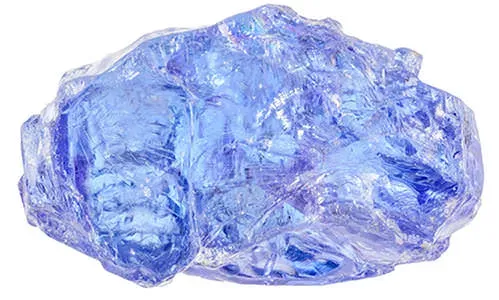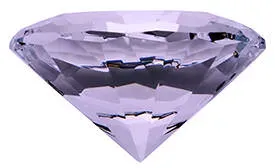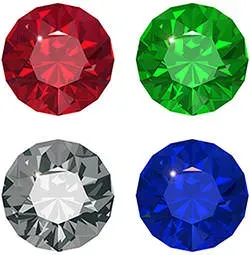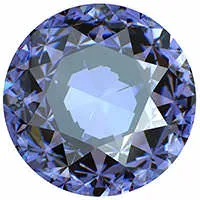 Tanzanite is a member of the mineral family zoisite, which has been known about for nearly two centuries. Zoisite occurs in a number of varieties, the most sought after being tanzanite. This mineral family was named zoisite in 1805, some time after the Austrian scientist Baron Siegmund Zois von Edelstein (1747-1819) had identified the mineral in the Saualpe Mountains of Carintha, Austria. Siegmund Zois von Edelstein operated an iron mine in the Karawanken Mountains in Karnten Austria and encountered the mineral on his own property. Centuries later, the discovery of a bright blue transparent variety that we now know as tanzanite, created a lot of excitement in the specialist world.
Tanzanite is a member of the mineral family zoisite, which has been known about for nearly two centuries. Zoisite occurs in a number of varieties, the most sought after being tanzanite. This mineral family was named zoisite in 1805, some time after the Austrian scientist Baron Siegmund Zois von Edelstein (1747-1819) had identified the mineral in the Saualpe Mountains of Carintha, Austria. Siegmund Zois von Edelstein operated an iron mine in the Karawanken Mountains in Karnten Austria and encountered the mineral on his own property. Centuries later, the discovery of a bright blue transparent variety that we now know as tanzanite, created a lot of excitement in the specialist world.
 A prospector named Manuel d'Souza who was looking for
A prospector named Manuel d'Souza who was looking for ![]() sapphire discovered tanzanite in 1967 in northeastern Tanzania. D'Souza was originally from India and had been looking for stones in the wilds of Tanzania. Eventually, some natives took him to an area in the region of the Merelani Hills near Mount Kilimanjaro, around 90 kilometers from his home town of Arusha. There, he found these precious blue stones he thought were sapphire. According to legend, the Masai herders were actually the ones who originally discovered the stone, when a lightning strike set the surrounding grasslands on fire. When they returned to the land with their livestock, the blue stones were all over the ground. D'Souza soon discovered that the blue stones he had found were not sapphire, so he staked a claim with the government and began mining.
sapphire discovered tanzanite in 1967 in northeastern Tanzania. D'Souza was originally from India and had been looking for stones in the wilds of Tanzania. Eventually, some natives took him to an area in the region of the Merelani Hills near Mount Kilimanjaro, around 90 kilometers from his home town of Arusha. There, he found these precious blue stones he thought were sapphire. According to legend, the Masai herders were actually the ones who originally discovered the stone, when a lightning strike set the surrounding grasslands on fire. When they returned to the land with their livestock, the blue stones were all over the ground. D'Souza soon discovered that the blue stones he had found were not sapphire, so he staked a claim with the government and began mining.
 With few inclusions, by 1970, the royal blue find was soon the focus of American and European publicity. When word of the new gemstones got out, Henry Platt of Tiffany and Co. named the new gem "tanzanite"" and Tiffany's began a marketing campaign to introduce it to the public. Now, tanzanite is the pride of the gem-rich East African country, Tanzania. Soon after word of this new precious stone got out however, a murderous attack put a swift end to exploitation of the mineral. A fake car accident, in which d'Souza died, interrupted any follow up supplies. As a result, supply was unable to keep up with demand during the following two years."
With few inclusions, by 1970, the royal blue find was soon the focus of American and European publicity. When word of the new gemstones got out, Henry Platt of Tiffany and Co. named the new gem "tanzanite"" and Tiffany's began a marketing campaign to introduce it to the public. Now, tanzanite is the pride of the gem-rich East African country, Tanzania. Soon after word of this new precious stone got out however, a murderous attack put a swift end to exploitation of the mineral. A fake car accident, in which d'Souza died, interrupted any follow up supplies. As a result, supply was unable to keep up with demand during the following two years."
 Some say D'Souza's discovery is one of the most exciting in the field of gemstones in nearly a century. Of all the new gemstones that have conquered the hearts of people in the second half of the twentieth century, none has even approximated the success of tanzanite. Within a short period of time it has succeeded in achieving worldwide popularity and major acclaim. The triggering factors for this market success are the virtues incorporated in tanzanite such as the beauty of its color, its rarity and durability, as well as its availability. Though it only rates a 6.5 on the hardness scale, its resistance to scratching and abrasion is relatively good.
Some say D'Souza's discovery is one of the most exciting in the field of gemstones in nearly a century. Of all the new gemstones that have conquered the hearts of people in the second half of the twentieth century, none has even approximated the success of tanzanite. Within a short period of time it has succeeded in achieving worldwide popularity and major acclaim. The triggering factors for this market success are the virtues incorporated in tanzanite such as the beauty of its color, its rarity and durability, as well as its availability. Though it only rates a 6.5 on the hardness scale, its resistance to scratching and abrasion is relatively good.
 Tanzanite has become one of the most popular gems in the market place. In fact, it is now the most popular gemstone after the "big four,"" which consists of diamonds, rubies, sapphires and emeralds. At first, the gemstone was only available in smaller sizes, but now much bigger sizes are sold. Today, tanzanite can cost over $2000 per carat in larger sizes at retail stores. Tanzanite is far less expensive than
Tanzanite has become one of the most popular gems in the market place. In fact, it is now the most popular gemstone after the "big four,"" which consists of diamonds, rubies, sapphires and emeralds. At first, the gemstone was only available in smaller sizes, but now much bigger sizes are sold. Today, tanzanite can cost over $2000 per carat in larger sizes at retail stores. Tanzanite is far less expensive than ![]() sapphire, for which it often serves as a substitute."
sapphire, for which it often serves as a substitute."
 Tanzanite stones are 585 million years old. There are apparently only very rare tanzanite stones that are naturally blue. Given its attractive color, rarity and the publicity, which greeted its discovery, the value of tanzanite is quite high, just a little less than that of the violet-blue sapphires it resembles. But it is rarely seen on the market and is very much a collector's item. Tiffany's has one of the largest and most beautiful displays of tanzanite in the world. The Smithsonian Institution also has an impressive collection consisting of one faceted stone of 122.7 carats and a rare cat's eye tanzanite of 18.2 carats.
Tanzanite stones are 585 million years old. There are apparently only very rare tanzanite stones that are naturally blue. Given its attractive color, rarity and the publicity, which greeted its discovery, the value of tanzanite is quite high, just a little less than that of the violet-blue sapphires it resembles. But it is rarely seen on the market and is very much a collector's item. Tiffany's has one of the largest and most beautiful displays of tanzanite in the world. The Smithsonian Institution also has an impressive collection consisting of one faceted stone of 122.7 carats and a rare cat's eye tanzanite of 18.2 carats.
 Because tanzanite was only first discovered in 1967, there is not much history, legend, or superstition about the gemstone. In Tanzania, however, women who have just given birth wear blue beads and fabric to bestow a healthy and positive life upon their newborns. This custom has been going on for generations in Tanzania.
Because tanzanite was only first discovered in 1967, there is not much history, legend, or superstition about the gemstone. In Tanzania, however, women who have just given birth wear blue beads and fabric to bestow a healthy and positive life upon their newborns. This custom has been going on for generations in Tanzania.
 Mentally, there are many ways in which tanzanite can be helpful to one's life. It has the power to transform negative energies into positive ones. It assists in manifesting your own self rather than being influenced by others or trying to conform to the norm
Mentally, there are many ways in which tanzanite can be helpful to one's life. It has the power to transform negative energies into positive ones. It assists in manifesting your own self rather than being influenced by others or trying to conform to the norm
 Tanzanite changes colors when it is viewed from different directions. This shifting of colors has been said to facilitate raising consciousness. It aids in realizing your own ideas and transforms destructive urges into constructive ones. The gemstone opens an awareness of the comparison between how one lives and how one could choose to live more consciously. Those who wear it will become aware of their calling. It is a stone for highly developed beings who have not yet recognized their strength and fearfully close their hearts to it. This creates trust and we gradually open ourselves for further possibilities. On the level of sub consciousness, it helps us to better come to terms with ourselves.
Tanzanite changes colors when it is viewed from different directions. This shifting of colors has been said to facilitate raising consciousness. It aids in realizing your own ideas and transforms destructive urges into constructive ones. The gemstone opens an awareness of the comparison between how one lives and how one could choose to live more consciously. Those who wear it will become aware of their calling. It is a stone for highly developed beings who have not yet recognized their strength and fearfully close their hearts to it. This creates trust and we gradually open ourselves for further possibilities. On the level of sub consciousness, it helps us to better come to terms with ourselves.
 Tanzanite dispels lethargy and brings repressed feelings to the surface so that they can be expressed. Tanzanite is a creative stone, bringing us back to our objectives after interruption. It also has the power to dissolve old patterns and creates space for new patterns to be integrated.
Tanzanite dispels lethargy and brings repressed feelings to the surface so that they can be expressed. Tanzanite is a creative stone, bringing us back to our objectives after interruption. It also has the power to dissolve old patterns and creates space for new patterns to be integrated.
 Physically, tanzanite is a wonderful tool to encourage recovery from severe illness or stress. It strengthens the immune system, regenerates cells, and treats the heart, spleen, pancreas, lungs, head, throat, and chest. The stone is also a great detoxifier. It also has the ability to neutralize over acidification and reduce inflammation. Tanzanite also stimulates fertility and heals diseases of the ovaries and testicles. It has been said that it is extremely beneficial to wear or place the tanzanite on the body in direct contact with the skin, where appropriate. It is recommended to wear the tanzanite for long periods of time, as it is a slow acting stone.
Physically, tanzanite is a wonderful tool to encourage recovery from severe illness or stress. It strengthens the immune system, regenerates cells, and treats the heart, spleen, pancreas, lungs, head, throat, and chest. The stone is also a great detoxifier. It also has the ability to neutralize over acidification and reduce inflammation. Tanzanite also stimulates fertility and heals diseases of the ovaries and testicles. It has been said that it is extremely beneficial to wear or place the tanzanite on the body in direct contact with the skin, where appropriate. It is recommended to wear the tanzanite for long periods of time, as it is a slow acting stone.
 Tanzanite rates a 6.5 on the hardness scale and has vitreous luster. It is a relatively soft and brittle stone, nowhere near as hard as a
Tanzanite rates a 6.5 on the hardness scale and has vitreous luster. It is a relatively soft and brittle stone, nowhere near as hard as a ![]() sapphire or a
sapphire or a ![]() diamond, but given the proper care it can last a long time.
diamond, but given the proper care it can last a long time.
 The typical color of tanzanite is blue with a violet tinge. In some lighter colored stones, the color is described as lavender. The color of the tanzanite is the most important factor in determining its price. For example, a tanzanite of the perfect blue brilliant hue in 5, 10 or 20 carats is of greater value than a paler, darker, or duller stone of twice the size and weight.
The typical color of tanzanite is blue with a violet tinge. In some lighter colored stones, the color is described as lavender. The color of the tanzanite is the most important factor in determining its price. For example, a tanzanite of the perfect blue brilliant hue in 5, 10 or 20 carats is of greater value than a paler, darker, or duller stone of twice the size and weight.
 In nature, tanzanite only sometimes occurs as a blue stone, but more often is golden to brown in color. After some time, it was discovered that by heating the brown or golden variety of the stone to 600 degrees Celsius and gradually cooling it, the color could be permanently changed to the violet-blue color. Without heating, tanzanite would be unmarketable.
In nature, tanzanite only sometimes occurs as a blue stone, but more often is golden to brown in color. After some time, it was discovered that by heating the brown or golden variety of the stone to 600 degrees Celsius and gradually cooling it, the color could be permanently changed to the violet-blue color. Without heating, tanzanite would be unmarketable.
 Tanzanite is pleochroic, meaning the purple, gray, blue and violet tones within the stone vary depending on the angle the stone is viewed from. There might also be a slight color change in incandescent light, when stones may appear to be more violet. Tanzanite's color is caused by the amount of chromium present in the stone.
Tanzanite is pleochroic, meaning the purple, gray, blue and violet tones within the stone vary depending on the angle the stone is viewed from. There might also be a slight color change in incandescent light, when stones may appear to be more violet. Tanzanite's color is caused by the amount of chromium present in the stone.
 Tanzanite's rich, royal velvety blue resembles the precious Kashmir
Tanzanite's rich, royal velvety blue resembles the precious Kashmir ![]() sapphire. Only a hint of violet and a slightly less hard and lustreous appearance than sapphire, tip off experts that the stone is something else. While at one point in time, tanzanite was used as a less expensive alternative to sapphire; it is now appreciated far more for itself and far less as a sapphire substitute. Tanzanite is much softer and fragile than sapphire and can occasionally shatter. It is important therefore, if you are having your tanzanite repaired or cleaned, that you make it clear that it is a tanzanite stone so extra care may be taken.
sapphire. Only a hint of violet and a slightly less hard and lustreous appearance than sapphire, tip off experts that the stone is something else. While at one point in time, tanzanite was used as a less expensive alternative to sapphire; it is now appreciated far more for itself and far less as a sapphire substitute. Tanzanite is much softer and fragile than sapphire and can occasionally shatter. It is important therefore, if you are having your tanzanite repaired or cleaned, that you make it clear that it is a tanzanite stone so extra care may be taken.
 Tanzanite is often round or oval cut. It is a stone that normally has few inclusions, but as in all gem stone families, large, clear, nearly flawless tanzanites are rare. The larger the stone, the greater the chance of flaws occurring.
Tanzanite is often round or oval cut. It is a stone that normally has few inclusions, but as in all gem stone families, large, clear, nearly flawless tanzanites are rare. The larger the stone, the greater the chance of flaws occurring.
 Being little known and of very recent history, this stone has neither been imitated nor produced synthetically. Tanzanite's fire factor, especially that of the splendid blue color, is comparatively high, for this reason the tanzanite alone of all the zoisite family can be classed with any other splendid gem. Tanzanite is a rare gem likely to gain in value as a collector's item.
Being little known and of very recent history, this stone has neither been imitated nor produced synthetically. Tanzanite's fire factor, especially that of the splendid blue color, is comparatively high, for this reason the tanzanite alone of all the zoisite family can be classed with any other splendid gem. Tanzanite is a rare gem likely to gain in value as a collector's item.
 Tanzanite occurs in schists and gneisses as well as in metasomatic rocks together with
Tanzanite occurs in schists and gneisses as well as in metasomatic rocks together with ![]() garnet, vesuvianite and actinolite. It is also occasionally found in hydrothermal veins. Tanzanite is found in very limited quantities, almost exclusively in the northern part of Tanzania, near the Merelani hills, where the chief deposit is almost exhausted by now. However small amounts of tanzanite has also been found in Sweden, New Hampshire, Pakistan, South Africa, Kenya, Norway, Austria, and Italy.
garnet, vesuvianite and actinolite. It is also occasionally found in hydrothermal veins. Tanzanite is found in very limited quantities, almost exclusively in the northern part of Tanzania, near the Merelani hills, where the chief deposit is almost exhausted by now. However small amounts of tanzanite has also been found in Sweden, New Hampshire, Pakistan, South Africa, Kenya, Norway, Austria, and Italy.
 Care must be taken when setting or handling a tanzanite. The stone is soft and brittle so it can crack if one is not careful. It is also important to avoid exposure to sudden temperature changes or heat. Tanzanite is also sensitive to pressure and has a low resistance to ultrasound so it should never be cleaned with the ultrasonic cleaners commonly used by jewelers. It can suffer irreparable damage. In general, tanzanite should be worn with care.
Care must be taken when setting or handling a tanzanite. The stone is soft and brittle so it can crack if one is not careful. It is also important to avoid exposure to sudden temperature changes or heat. Tanzanite is also sensitive to pressure and has a low resistance to ultrasound so it should never be cleaned with the ultrasonic cleaners commonly used by jewelers. It can suffer irreparable damage. In general, tanzanite should be worn with care.